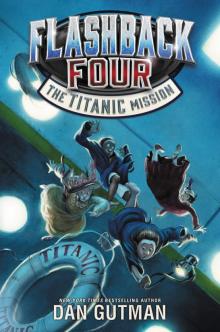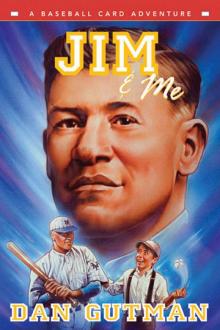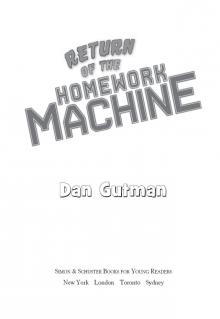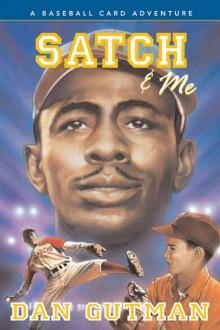- Home
- Dan Gutman
The Titanic Mission
The Titanic Mission Read online
DEDICATION
TO NINA, SAM, AND EMMA
EPIGRAPH
There is nothing that man can build that nature cannot destroy, and far as he may advance in might and knowledge and cunning, her blind strength will always be more than his match.
—Filson Young, Titanic
ACKNOWLEDGMENTS
Special thanks to the people who helped me with this project: Ray Dimetrosky, David Lubar, Craig Provorny, Nina Wallace, and Howard Wolf.
CONTENTS
Dedication
Epigraph
Acknowledgments
Introduction
Chapter 1: The Flashback Four
Chapter 2: Another Chance
Chapter 3: Getting Ready
Chapter 4: Going Back
Chapter 5: A Small City
Chapter 6: Decisions
Chapter 7: Second Thoughts
Chapter 8: Ice
Chapter 9: It’s Happening
Chapter 10: All Hands on Deck
Chapter 11: King of the World
Chapter 12: Every Man for Himself
Chapter 13: The Shot
Chapter 14: The Dead and Dying
Chapter 15: Staying Alive
Chapter 16: A Beautiful Morning
Chapter 17: The Future
Epilogue
Facts & Fictions
About the Author
Back Ads
Books by Dan Gutman
Credits
Copyright
About the Publisher
INTRODUCTION
IT WAS TWENTY MINUTES BEFORE MIDNIGHT when steel touched ice.
The date: April 14, 1912.
The place: the north Atlantic Ocean, about 370 miles southeast of Newfoundland.
It was cold outside. So cold. As cold as ice.
The ocean was flat and calm that night, almost like a sheet of glass. The largest ship in the world at the time—the Titanic—had nearly completed its maiden voyage. It sliced through the water at top speed, close to twenty-four miles per hour.
The sky was clear, cloudless, and almost moonless, except for a tiny sliver. But the stars were bright and sometimes shooting. So peaceful. It must have been tempting to take one’s eye off the distant horizon and gaze up at the star show above.
Maybe that’s what happened. Maybe the lookout glanced up and saw a shooting star. He couldn’t take his eyes off it. And then, when he returned his gaze to the horizon moments later, he saw it directly in front of him—an enormous mountain of ice.
In Greek mythology, the Titans were a race of giant gods with incredible strength who ruled the Golden Age. That’s how the Titanic got its name.
It would seem like no contest—frozen water versus hard steel. But it was the steel that broke, not the ice.
The iceberg towered sixty feet high, and that was just the part of it that was above the waterline. It was eight times larger below the surface, and four times the size of the Titanic steaming directly toward it—a million tons of ice.
Everything happened so fast after that. The lookout turned around and frantically rang the emergency bell three times.
“Hard starboard!” somebody on the bridge shouted almost immediately.
But it was far too late. It’s not easy to turn around a vessel that’s nine hundred feet long and weighs over forty-six thousand tons. It takes time, and that was one thing in short supply. Titanic was only a quarter mile away from the iceberg and closing fast.
It’s easy to say now, but it probably would have been better if the Titanic hadn’t turned at all. It should have just rammed the iceberg head-on. The front of the ship was designed to take a hit. It might have survived the damage. The sides of the ship were much more fragile.
Just thirty-seven seconds after the emergency bell rang, steel touched ice on the front right side of Titanic—the starboard side. The impact was ten feet above the keel, but well below the waterline.
There was no crash. No jolt. It appeared to be a glancing blow. A little bump. Harmless. Titanic didn’t even stop moving forward. The iceberg didn’t break apart. It was like . . . two ships passing in the night.
But the hull of the Titanic—like any large ship—was made of hundreds of overlapping steel plates, each of them just an inch and a half thick. These plates were held in place by iron rivets. The rivets were small, just an inch thick and three inches long. When ice touched steel, something had to give.
It was the rivets. Iron isn’t as strong as steel. One at a time the rivets popped off. Pop. Pop. Pop. The heads of the rivets had been sliced off, like mushrooms.
The hull didn’t open up like a zipper or a can opener, the way it has sometimes been described. Without rivets to hold them in place, the steel plates that lined the ship were roughly shoved aside, like a toddler ripping the wrapping paper off a birthday present.
Water gushed in the gash, four hundred tons of it a minute. The sixteen “watertight” compartments that lined the hull began to fill.
Only some of the passengers on board heard the rumbling, grinding noise below deck. Most of them were asleep and didn’t notice a thing.
And then, just like that, it was over. The iceberg floated on by as if nothing unusual had happened. It was chipped in a few places but none the worse for wear.
In less than ten seconds, the damage had been done to Titanic. That’s all it took. The “unsinkable” ship was fatally injured. And the unthinkable was about to happen.
CHAPTER 1
THE FLASHBACK FOUR
TO TELL THIS STORY THE WAY IT SHOULD BE TOLD, we need to go back, or, I should say, forward in time.
The story begins in the present day, in the left field bleachers at Fenway Park in Boston, Massachusetts. The Red Sox are playing the Yankees, but the ball game is secondary to what’s going on in the stands.
Sitting in the front row above Fenway’s famous Green Monster are four sixth-grade students. You already met them if you read a book called Flashback Four: The Lincoln Project. If you haven’t read it, you really should. If you have read it, all the better.
It’s impossible and really unfair, of course, to sum up a human being in just a few sentences. But at the same time, you don’t want to sit through page after page of character description. You’ll get to know these young people better as the story goes on. But for now we’re all busy, so here goes . . .
Luke: A big white kid from the streets of Dorchester. He’s got a touch of ADD and a heart of gold.
Julia: A prep school blonde who likes money, clothes, and taking risks, maybe a little too much.
David: A tall, thin African American kid who likes to laugh but knows when to get serious.
Isabel: A studious kid originally from the Dominican Republic who plays by the rules, and expects to be rewarded for it.
Two boys. Two girls. They call themselves the Flashback Four. They didn’t know each other until quite recently. They go to separate schools. But they bonded, as often happens when people are thrown into a life-or-death situation together. In surviving the Lincoln Project they became friends, and they’d decided to get together to talk about their future . . . and the past.
Luke and David are serious Red Sox fans, but that’s not how the Flashback Four found themselves in Fenway Park that day. They got the tickets from Julia’s father, a wealthy Boston hedge fund manager.
I know what you’re thinking. There can’t be a lot of money in managing hedges. But Julia’s dad did quite well for himself and had season tickets. Taking his wealthy clients to Fenway was good for business. He had four tickets he wasn’t using on this particular day and offered them to Julia.
This is a girl who doesn’t know the difference between a foul ball and a grand slam. But she knew the boys wo
uld appreciate it, and she thought it would be a nice way to get the group together after they got back from their first adventure.
“Free tickets to see the Sox play the Yankees!” Luke said, high-fiving David as they found their seats. “It doesn’t get much better than this.”
“Baseball is such a bore.” Julia yawned. “What do they have to eat around here?”
Neither team scored in the first inning, but the Flashback Four weren’t paying much attention to the game anyway. They were still recovering from what had happened at Gettysburg.
To put it simply, they had been recruited by a billionaire—Miss Chris Zandergoth—who had earned her fortune developing an online dating site called Findamate. She spent a big chunk of that fortune creating an interactive smartboard that could function as a time-traveling device.
It was simply called the Board. If you think the smartboard in your school is high-tech, you ain’t seen nothin’. This was a smarter board. Don’t even try to understand the technology. It’s for super techies.
Anyway, Miss Zandergoth sent the Flashback Four to 1863 with a mission—to take a photograph of Abraham Lincoln delivering the Gettysburg Address. Miss Z, as she is called, has an obsession with photos of historical events, and especially historical events that have never been photographed before. There is no existing photo of Lincoln giving that speech. Go ahead, look it up. Or just take my word for it.
Luke, Julia, Isabel, and David were able to witness the Gettysburg Address in person, but unfortunately they were not able to bring back a photo of Lincoln delivering it. In fact, they were attacked and jailed, and poor Julia even had the misfortune to step in a pile of 1863 dog poop. To tell you the truth, the Flashback Four were lucky to get back to the present day with their lives. If you want the full story, again, read the book.
The Red Sox took the field to start the second inning. Luke had just come back to the seats with hot dogs for everybody.
“Y’know,” Isabel said as she took a bite, “with the Board, we could travel to any moment in time and take a picture of it.”
“Obviously,” David said.
“Where do you think Miss Z will send us next?” Luke asked.
The possibilities were endless. The first photograph ever taken was in 1826. So no photos exist of anything that happened before that year. They could go back to Christmas night of 1776 and photograph George Washington with his troops, crossing the Delaware to launch a surprise attack on the British army at Trenton. Or they could go back to 1510 and photograph Michelangelo as he painted his masterpiece on the ceiling of the Sistine Chapel. Or they could go back to prehistoric times and snap a photo of a dinosaur.
“You know what would be cool?” Isabel said. “We could take a picture of the Wright Brothers flying the first airplane at Kitty Hawk, North Carolina.”
“I’m pretty sure there’s already a picture of that,” Luke said. “I think I saw it in a book once.”
Luke was right. Orville and Wilbur Wright very carefully documented their experiments with flying machines, and they had a member of the Kill Devil Hills Lifesaving Station snap a photo just as Orville lifted off the ground for the first time on December 17, 1903. The flight lasted all of twelve seconds. It was one of the most famous photographs of the twentieth century. So there was no point in trying to take that picture.
It only took a few seconds for Julia to find it on her smartphone. . . .
The first batter for the Yankees grounded out, and the second one singled up the middle.
The Flashback Four discussed a few other possibilities for photos. Amazingly, nobody had thought to take a photograph of generals Ulysses S. Grant and Robert E. Lee signing the agreement to end the Civil War. There was no photograph of Amelia Earhart crash-landing her plane on a remote island in the Pacific Ocean, of course. A photo of the Founding Fathers signing the Declaration of Independence would be amazing. Many famous events in history can only be imagined from paintings that were made of them.
As the next Yankee stepped up to the plate, a message flashed on the scoreboard. None of the Flashback Four noticed it at first. . . .
DID YOU KNOW . . .
the message read,
FENWAY PARK IS THE OLDEST MAJOR LEAGUE BALLPARK IN AMERICA?
“Who cares?” muttered Julia, glancing up at the scoreboard as she took a bite of her hot dog.
IT OPENED ON APRIL 20, 1912.
“Big deal,” muttered Julia.
HERE ARE A FEW OTHER FAMOUS EVENTS THAT HAPPENED IN 1912. . . .
• JANUARY: The Republic of China was established
• FEBRUARY: Arizona became the 48th state
• MARCH: The Dixie Cup was invented
• APRIL: The TITANIC sank in the Atlantic Ocean
The word Titanic caught Isabel’s eye as she glanced up at the scoreboard. The story of the Titanic was one of those things that just about everybody knew, even though it happened so long ago and it isn’t taught in schools. It was one of the most famous events of the twentieth century. Isabel had seen the 1997 movie Titanic during a sleepover at a friend’s house. She nudged Julia, who Googled the word Titanic on her smartphone.
“It says here that the Titanic sank on April 15, 1912,” she said. “That was just five days before this ballpark opened.”
Nobody said anything for a minute or two. The Yankee batter took a couple pitches out of the strike zone, and then grounded into a double play, throwing the Red Sox fans into a frenzy. David turned to Luke.
“Are you thinking what I’m thinking?” he asked.
“I think I’m thinking exactly what you’re thinking,” Luke replied. “Is there a photo of the Titanic sinking?”
Isabel looked it up on her phone.
“No,” she reported. “It says here that there are plenty of pictures of the Titanic before it set sail, but no photos of it actually sinking.”
“Why not?” asked Julia. “They had cameras in 1912.”
“All the cameras that were on board probably went down with the ship,” David guessed, “and the people in the lifeboats couldn’t bring anything with them. They were just trying to stay alive.”
“It was women and children first,” Isabel noted. “Maybe in those days, women weren’t allowed to use cameras. We couldn’t even vote until 1920.”
The Yankee batter struck out to end the inning, causing the crowd to erupt in cheers, but none of the Flashback Four were paying attention to the game anymore.
“Can you imagine how cool it would be to sail on the Titanic?” asked Luke.
“I would do it,” Julia said. “We would get to hobnob with all those rich society people.”
“Count me out, guys,” Isabel announced. “Too dangerous for me.”
She had pulled out her own phone and was scrolling through various websites about the Titanic. She learned that the ship was going too fast that night. The captain ignored multiple warnings about icebergs in the area. The rivets holding the ship together should have been made of steel instead of iron. There weren’t enough lifeboats for all the passengers. The lookout didn’t even have binoculars, because they were locked in a locker and nobody had the key! So many things had gone wrong, and fifteen hundred people had died.
“What, do you want to spend your whole life staring at a cell phone?” David told her. “Come on. We could do this. YOLO. You only live once.”
“And you only die once!” Isabel replied. “Are you crazy? It would be a suicide mission! Most of the people on the Titanic died, you know. We almost got killed just going to Gettysburg. Do you think we’re going to survive on a ship that’s going to sink?”
“Yeah, we’ll survive,” Luke said calmly. “Because we have something none of those Titanic passengers had.”
“What?” asked Isabel.
“The Board,” Luke said, looking at her. “As soon as we snap the picture, Miss Z will zap us back home. Easy peasy. We’re not going to die. You don’t even have to get your feet wet.”
“Hmmm,” Is
abel said. “I didn’t think of it that way.”
CHAPTER 2
ANOTHER CHANCE
THE RED SOX ENDED UP WINNING THE GAME THAT day, but even Luke—the most diehard fan of them all—wasn’t able to get that excited about it. He couldn’t stop thinking about traveling back to April 15, 1912, to take a photo of the Titanic before it slipped under the water. After much discussion—and a good amount of ice cream and popcorn—Luke, David, and Julia convinced Isabel to go along with what they had dubbed “the Titanic Mission.”
As soon as school let out the next day, the Flashback Four gathered at 200 Clarendon Street in downtown Boston to discuss the idea with Miss Zandergoth.
“Okay, let’s do this thing,” Luke said when Julia showed up a few minutes after the others.
The John Hancock Tower is a sixty-story skyscraper with hundreds of business offices of all kinds. As they pushed through the revolving door into the lobby, all four members of the Flashback Four felt more confident than they had before the Lincoln Project. They knew their way around this place. Only a few people were waiting for the elevator. Isabel pushed the button.
“That doesn’t do anything, you know,” David told her.
“What do you mean it doesn’t do anything?” she replied. “Of course it does something. When you push the button, it calls the elevator.”
“Nah, the elevators are programmed to go up and down at predetermined times,” David told her. “It’s gonna come whether you press the button or not.”
“What?!” asked Julia. “You’re nuts. If the button doesn’t do anything, what’s the point of having it here?”
“They just put the button there to give people the feeling that they’re in control,” David informed her. “It’s the same thing with those signals at intersections that tell you when to walk across the street. Those buttons don’t do anything either. It’s all a sham.”
“Where’d you hear that?” asked Luke.

 My Weirder-est School #3
My Weirder-est School #3 Bummer in the Summer!
Bummer in the Summer! Flashback Four #4
Flashback Four #4 Miss Blake Is a Flake!
Miss Blake Is a Flake! My Weirder-est School #2
My Weirder-est School #2 My Weirder-est School #1
My Weirder-est School #1 Miss Aker Is a Maker!
Miss Aker Is a Maker! Houdini and Me
Houdini and Me Mr. Marty Loves a Party!
Mr. Marty Loves a Party! Ms. Jo-Jo Is a Yo-Yo!
Ms. Jo-Jo Is a Yo-Yo! Jackie & Me
Jackie & Me Miss Newman Isn't Human!
Miss Newman Isn't Human! Miss Mary Is Scary!
Miss Mary Is Scary! Miss Laney Is Zany!
Miss Laney Is Zany! Miss Tracy Is Spacey!
Miss Tracy Is Spacey! Ms. Krup Cracks Me Up!
Ms. Krup Cracks Me Up! Mrs. Cooney Is Loony!
Mrs. Cooney Is Loony! Dr. Nicholas Is Ridiculous!
Dr. Nicholas Is Ridiculous! My Weird School Special
My Weird School Special The Titanic Mission
The Titanic Mission Ted & Me
Ted & Me Jim & Me
Jim & Me Miss Child Has Gone Wild!
Miss Child Has Gone Wild! The Talent Show
The Talent Show Mickey & Me
Mickey & Me Return of the Homework Machine
Return of the Homework Machine The Lincoln Project
The Lincoln Project Ray & Me
Ray & Me We're Red, Weird, and Blue! What Can We Do?
We're Red, Weird, and Blue! What Can We Do? The Get Rich Quick Club
The Get Rich Quick Club Funny Boy Versus the Bubble-Brained Barbers from the Big Bang
Funny Boy Versus the Bubble-Brained Barbers from the Big Bang Never Say Genius
Never Say Genius Miss Brown Is Upside Down!
Miss Brown Is Upside Down! Coach Hyatt Is a Riot!
Coach Hyatt Is a Riot! The Christmas Genie
The Christmas Genie Mr. Burke Is Berserk!
Mr. Burke Is Berserk! Mr. Louie Is Screwy!
Mr. Louie Is Screwy! Mrs. Roopy Is Loopy!
Mrs. Roopy Is Loopy! Ms. Sue Has No Clue!
Ms. Sue Has No Clue! Satch & Me
Satch & Me Mr. Cooper Is Super!
Mr. Cooper Is Super! Oh, Valentine, We've Lost Our Minds!
Oh, Valentine, We've Lost Our Minds! Miss Small Is off the Wall!
Miss Small Is off the Wall! Ms. LaGrange Is Strange!
Ms. LaGrange Is Strange! Funny Boy Meets the Dumbbell Dentist from Deimos (with Dangerous Dental Decay)
Funny Boy Meets the Dumbbell Dentist from Deimos (with Dangerous Dental Decay) Miss Daisy Is Still Crazy!
Miss Daisy Is Still Crazy! Ms. Leakey Is Freaky!
Ms. Leakey Is Freaky! The Homework Machine
The Homework Machine Miss Holly Is Too Jolly!
Miss Holly Is Too Jolly! Mrs. Meyer Is on Fire!
Mrs. Meyer Is on Fire! Mrs. Master Is a Disaster!
Mrs. Master Is a Disaster! Ms. Beard Is Weird!
Ms. Beard Is Weird! Shoeless Joe & Me
Shoeless Joe & Me Funny Boy Meets the Airsick Alien from Andromeda
Funny Boy Meets the Airsick Alien from Andromeda My Weird School Special: It’s Halloween, I’m Turning Green!
My Weird School Special: It’s Halloween, I’m Turning Green! Mrs. Lane Is a Pain!
Mrs. Lane Is a Pain! Miss Klute Is a Hoot!
Miss Klute Is a Hoot! Babe & Me
Babe & Me The Genius Files 2 Never Say Genius
The Genius Files 2 Never Say Genius Mr. Nick Is a Lunatic!
Mr. Nick Is a Lunatic! Roberto & Me
Roberto & Me Mrs. Lizzy Is Dizzy!
Mrs. Lizzy Is Dizzy! Mrs. Dole Is Out of Control!
Mrs. Dole Is Out of Control! Mrs. Patty Is Batty!
Mrs. Patty Is Batty! Mr. Granite Is from Another Planet!
Mr. Granite Is from Another Planet! Dr. Brad Has Gone Mad!
Dr. Brad Has Gone Mad! Mr. Jack Is a Maniac!
Mr. Jack Is a Maniac! Funny Boy Takes on the Chit-Chatting Cheeses from Chattanooga
Funny Boy Takes on the Chit-Chatting Cheeses from Chattanooga Dr. Carbles Is Losing His Marbles!
Dr. Carbles Is Losing His Marbles! Abner & Me
Abner & Me Ms. Hannah Is Bananas!
Ms. Hannah Is Bananas! My Weirdest School #2
My Weirdest School #2 The Kid Who Became President
The Kid Who Became President Mrs. Kormel Is Not Normal!
Mrs. Kormel Is Not Normal! Getting Air
Getting Air Mission Unstoppable
Mission Unstoppable Nightmare at the Book Fair
Nightmare at the Book Fair License to Thrill
License to Thrill Mrs. Jafee Is Daffy!
Mrs. Jafee Is Daffy! Mr. Sunny Is Funny!
Mr. Sunny Is Funny! Mr. Hynde Is Out of His Mind!
Mr. Hynde Is Out of His Mind! The Kid Who Ran For President
The Kid Who Ran For President The Genius Files #4
The Genius Files #4 Honus & Me
Honus & Me Mr. Tony Is Full of Baloney!
Mr. Tony Is Full of Baloney! Miss Suki Is Kooky!
Miss Suki Is Kooky! Ms. Hall Is a Goofball!
Ms. Hall Is a Goofball! Officer Spence Makes No Sense
Officer Spence Makes No Sense The Pompeii Disaster
The Pompeii Disaster Mr. Will Needs to Chill!
Mr. Will Needs to Chill! Willie & Me
Willie & Me Ms. Todd Is Odd!
Ms. Todd Is Odd!